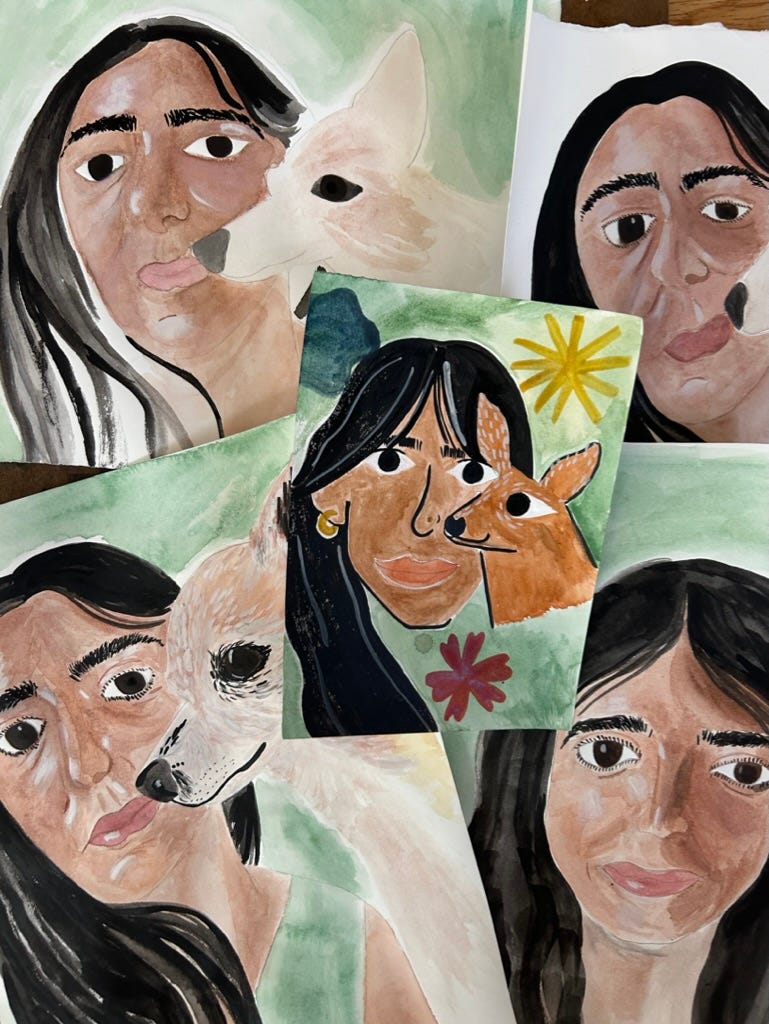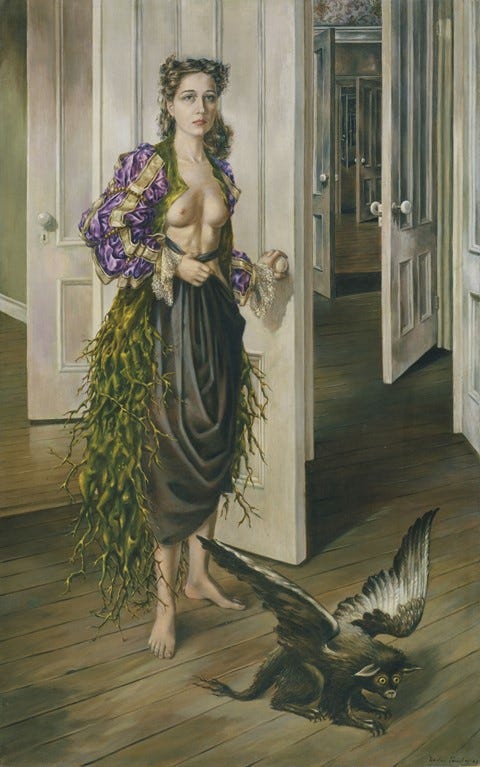Listen to Take Your Time
Here is a special audio treat for Take Your Time #15.
Illustration
I turned 35 this month and decided to do a self-portrait. I’ve been looking at a lot of self-portraits for inspiration, hence the next section of this issue! As I work on my own, I want to capture some surreal magic that animals add to the self-potraits, while also capturing the way the artists extended their self-image through the animal figure and the background. It’s sort of like how astrology and zodiac symbols give us a framework to apply animals to our personalities. My senior dog Scooter will be part of my self-portrait, probably to no one’s surprise, but I’m still figuring out how to portray our friendship spatially.
Inspiration
Portraits of women and animals inspire this issue. A portrait or self-portrait shows a person’s story, expresses their inner world, creates a sense of importance, and even gives the subject immortality to live on forever in art. What’s most intriguing about self-portraiture is artists’ representation of themselves and using it as a place to define themselves through their art instead of being defined by others.
While gathering images for this issue, I noticed many artists included real or made-up animal accompaniments or guardians in their work. Some interpret animals as an embodiment of freedom and independence, maybe a desire or dream, perhaps unrealized by the artist. Maybe the artists simply found comfort, love, and connection with these treasured animal subjects. Below are four fantastical, intriguing, enigmatic works from Leonora Carrington, Remedios Varo, Frida Kahlo, and Dorothea Tanning depicting a female subject (all considered self-portraits) and an animal companion.
“I’m like a hyena; I get into the garbage cans. I have an insatiable curiosity.”
- Leonora Carrington
Leonora Carrington once wrote a story called The Debutante. In it, a young debutante doesn’t want to go to the ball and instead sends a hyena in her place. After murdering and eating her maid, the hyena dons her maid’s face as a mask to wear to the ball and apparently fools everyone at the party, at least for a while. I like to remember this story when looking at Self-Portrait (Inn of the Dawn of the Horse) and find the similarities between the hyena and Carrington. The mane of the hyena and her wild hair, both of their gazes turned toward us, and the lift of the hyena’s paw and her hand towards one another. It’s witchy and dream-like. While horses are prominent in Carrington’s work, often representing freedom, independence, and imagination, the hyena in her painting is more compelling to me personally. Hyenas are predators, carnivores, scavengers, matrilineal, and seem to be quite misunderstood. The spotted hyena also produces an absolutely haunting sound when they feel threatened or scared. At the end of The Debutante, the hyena eats the face of the maid they used as a mask and jumps out the window, claiming, “Well, as for me, I do not eat cake.”
In Sympathy, interpreted as a self-portrait, Varo fantastically depicts a tender scene between a woman and a cat that perhaps slipped on the red tablecloth and knocked a glass of water over, resulting in a river on the ground. The woman and cat resemble one another a great deal in color, their eyes, and their spiky flame-like hair. Do you see those three tails at the base of the figure’s dress? Perhaps they’re more alike than we think. Look at how they gaze at one another and the slight touch of the hand to paw. The woman’s other hand scratches the back of the cat, which seems to produce sparks of magic or show the electricity or their connection.
When Frida Kahlo gifted the piece Fulang Chang and I to her friend Mary Schapiro Sklar, she included a mirror with a similar frame and told Mary to hang the painting and mirror side-by-side so that Mary could always see herself next to Frida. The self-portrait depicts Frida with her long black hair parted in the middle and a pink ribbon intertwined in her hair and around Fulang Chang’s neck, connecting them literally and symbolically. A shiny, satiny pink ribbon invokes a softness and tenderness. Both Kahlo and Fulang Chang gaze right directly at us, the viewer. Fulang Chang is in front of Kahlo, which feels protective. Monkeys symbolized fertility, wildness, mischief, and cheekiness.
Frida Kahlo kept spider monkeys, like Fulang Chang, dogs, birds, and a fawn as pets at her home, Casa Azul in Coyoacán, Mexico City. She painted 55 self-portraits with her animal companions. According to Kahlo, the monkeys symbolized the children she always wanted to have but never could after a horrific bus accident, which left her with injuries she never recovered from.
Dorothea gazes past us and opens the door into an expansive hallway with infinite open doors beckoning her through. To where, though? It feels like a maze of many opportunities and possibilities. And what of the winged creature beside her feet also gazing past us? It reminds me of a chimera. Max Ernst, whom Tanning later married, gave the painting its title. Birthday may refer to a metamorphosis, a change, or a re-birth from one state to another.
What’s intriguing about these portraits is how the animals are used in a specific and personal way, which reveals some things about the artist and, at the same time, makes them even more enigmatic and harder to understand. These portraits have a fanciful world-building quality that suggests new super-intimate and telepathic relationships between animals, which communicate that particular ultra-sensitivity to the world that artists are always trying to tap into.
Ideas
Faith Ringgold, quilt and visual artist, dies at 93
“I became fascinated with the ability of art to document the time, place, and cultural identity of the artist. How could I, as an African American woman artist, document what was happening around me?”
- Faith Ringgold
What can I even say about Faith Ringgold that hasn’t already been said? She was a pioneer, visionary, quilter, painter, sculptor, performance artist, and children’s book writer/artist. What I admire even more than her prolificity is how seriously she took art as a way to depict the realities of life in America. She didn’t hold back about the brutality, racism, and violence around her, and her work is so prescient today. I recall seeing American People Series #20: Die once at MoMa while visiting my sister in New York City. The two screaming, crying children clinging to one another feels like a warning about the consequences of all types of violence that pervade our society.
In Zen Painting, It Takes Years of Practice to Do Almost Nothing “Two longtime painters recently told me how joyful their studio practices had become in their 40s once they took their minds off their ambitions, stopped trying to impress anyone, and just let the paintings paint themselves.” Less really is more! It feels like a radical concept and the antithesis of contemporary life as we know it!
Is This Stingray-Shaped Rock the Oldest Known Animal Art? It’s possible that this stingray-shaped rock “blows the known dates for human representations of animals out of the water.” The piece is estimated to be roughly 130,000 years old! It’s beautiful to think of this being preserved, someone tracing a stingray shape into the sand and maybe walking away thinking the waves would erase it.
Ending
This is a poem called Crows by the poet Marilyn Nelson. Nelson said of the poem: “I was watching crows eat the holiday leftovers I’d tossed out onto the snow. They really liked the coconut macaroons.”
What if to taste and see, to notice things,
to stand each is up against emptiness
for a moment or an eternity—
images collected in consciousness
like a tree alone on the horizon—
is the main reason we’re on the planet.
The food’s here of the first crow to arrive,
numbers two and three at a safe distance,
then approaching the hand-created taste
of leftover coconut macaroons.
The instant sparks in the earth’s awareness.









